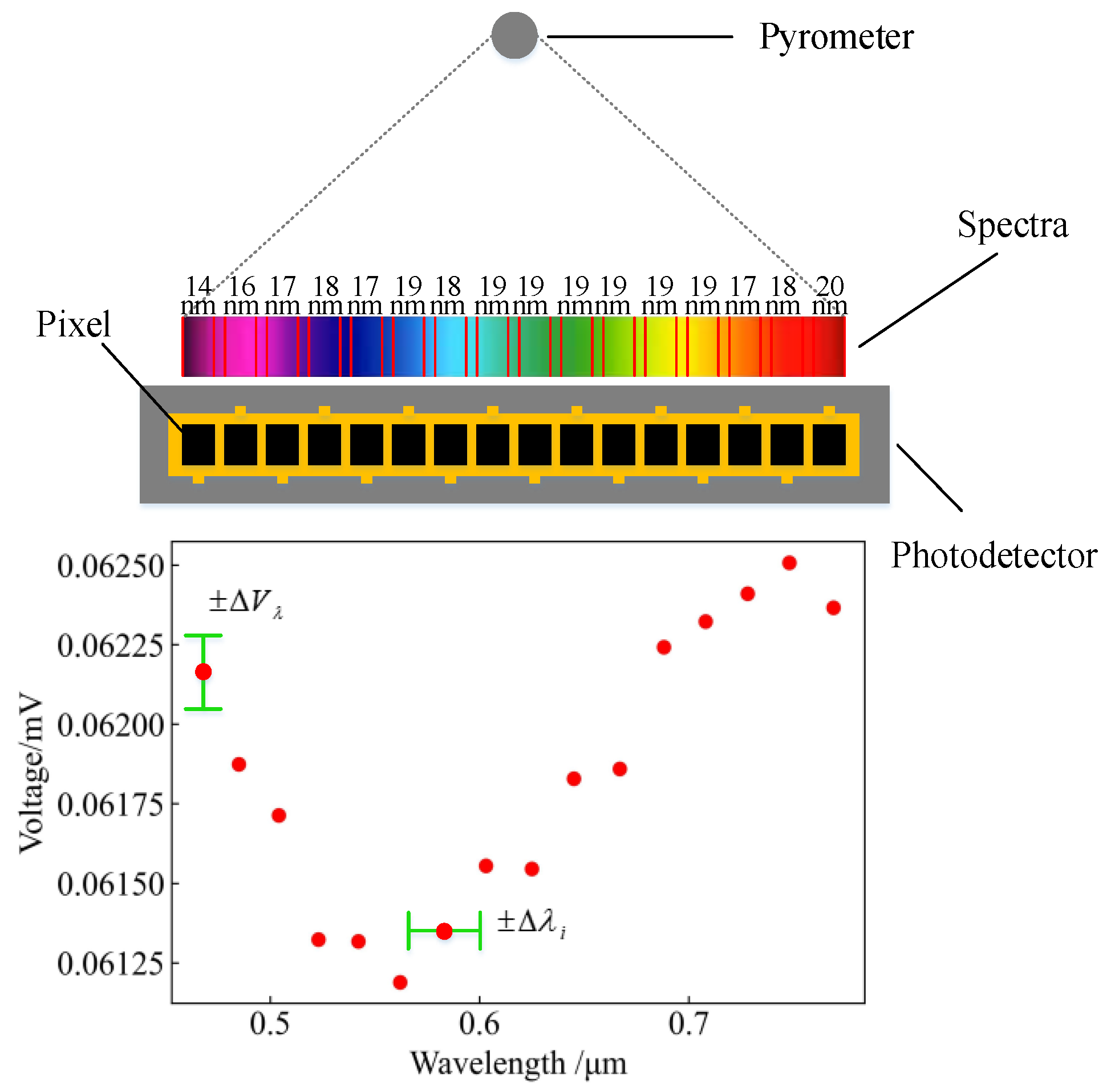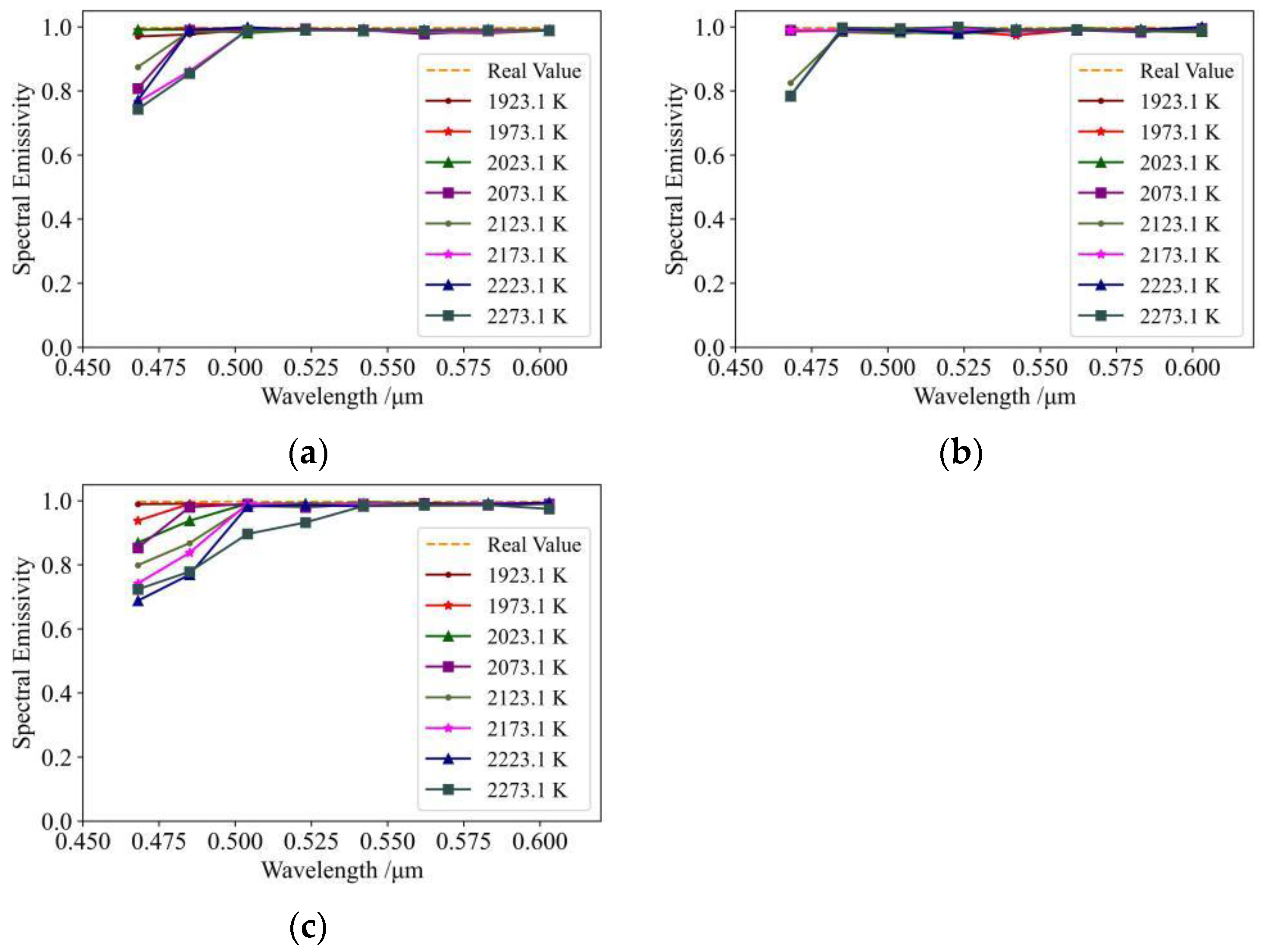Multispectral Thermometry Method Based on Optimisation Ideas
Abstract
1. Introduction
2. Principles of Temperature Inversion
2.1. Temperature Difference Function
2.2. Function Extreme Value Optimisation
- Modelling: In line with the principles of multispectral thermometry, as well as the principle of error correction, a temperature model is established, as expressed in Equation (2). The model not only avoids the error problem caused by inaccurate calibration of the system, but also corrects any measurement errors arising from the experimental process.
- Parameter determination: The following parameters need to be determined before function optimisation can be carried out:
- ○
- Measurement error determination: is generated in the process of temperature calibration, so the temperature error of the blackbody furnace, the temperature calibration device, is taken as the temperature measurement error. In addition, , and are generated during assembly and usage of the spectral temperature measurement device, so it is necessary to determine the wavelength and voltage errors in combination with the spectral distribution of the temperature measurement device.
- ○
- Determination of correction factors: In the process of assembling the thermometer, the coupling between the lens and the workpiece requires the use of optical glue and metal screws. This means that the relative positions of the spectrum and the detector, and the energy intensity between them, are not distributed as designed by the simulation. Measurement errors are also introduced by the scattering phenomenon and the working environment of the test. Factors causing measurement errors, such as the amounts of optical glue and metal material, were also recorded several times in the course of the present study. The amounts of optical glue and metal material, and all the resulting error data, were recorded and input into the neural network to establish a learning model and predict the values of the correction factors , , and in the range [−1,1].
- ○
- Determination of initial emissivity value: From the relevant theory of spectral thermometry, it can be seen that the spectral emissivity of the object to be measured is in a range of (0, 1). In order to invert the target temperature without limiting the range of emissivity, and to prevent the accuracy of the thermometry from being dependent on the initial value of the emissivity, a randomly selected floating point number is used as the initial value of the emissivity in the range of (0, 1).
- Function optimisation: Through the derivation of equations from Equations (3) and (4), the multispectral thermometry problem can now be transformed into a function extreme value optimisation problem. The optimisation function and constraints are shown in Equation (6). The function extreme value optimisation code can be implemented with the help of algorithms such as Particle Swarm, Gradient Descent and neural network.
- Secondary optimisation: After function optimisation is used to determine the extreme value, the spectral emissivity value can be obtained by calculation; this can be re-substituted into the temperature difference function for the second optimisation. By such means, the inversion of the spectral emissivity and the true temperature may ultimately be obtained.
3. Experimental Validation
3.1. Experimental Setup
3.2. Results
3.3. Advantages of the Method Proposed in this Paper
4. Discussion
Effect of Spectral Data Correction on Spectral Emissivity Solution
5. Conclusions
Author Contributions
Funding
Institutional Review Board Statement
Informed Consent Statement
Data Availability Statement
Acknowledgments
Conflicts of Interest
References
- Araujo, A. Analysis of multi-band pyrometry for emissivity and temperature measurements of gray surfaces at ambient temperature. Infrared Phys. Technol. 2016, 76, 365. [Google Scholar] [CrossRef]
- Wen, C.D. Investigation of steel emissivity behaviors: Examination of Multispectral Radiation Thermometry (MRT) emissivity models. Int. J. Heat Mass Transf. 2010, 53, 2035–2043. [Google Scholar] [CrossRef]
- Weng, K.H.; Wen, C.D. Effect of oxidation on aluminum alloys temperature prediction using multispectral radiation thermometry. Int. J. Heat Mass Transf. 2011, 54, 4834–4843. [Google Scholar] [CrossRef]
- Liang, M.; Sun, B.J.; Sun, X.G.; Xie, J.Y. Development of a new fiber-optic multi-target multispectral pyrometer for achievable true temperature measurement of the solid rocket motor plume. Measurement 2017, 95, 239–245. [Google Scholar] [CrossRef]
- Hay, A.D.; Peters, T.J.; Wilson, A.; Fahey, T. The use of infrared thermometry for the detection of fever. Br. J. Genaral Prat. 2004, 54, 448–450. [Google Scholar]
- Hobbs, M.J.; Barr, A.; Woolford, S.; Farrimond, D.; Clarke, S.D.; Tyas, A.; Willmott, J.R. High-Speed Infrared Radiation Thermometer for the Investigation of Early Stage Explosive Development and Fireball Expansion. Sensors 2022, 22, 6143. [Google Scholar] [CrossRef]
- Fu, T.R.; Liu, J.F.; Tang, J.Q.; Duan, M.H.; Zhao, H.; Shi, C.L. Temperature measurements of high-temperature semi-transparent infrared material using multi-wavelength pyrometry. Infrared Phys. Technol. 2014, 66, 49–55. [Google Scholar] [CrossRef]
- Neupane, S.; Jatana, G.S.; Lutz, T.P.; Partridgeand, W.P. Development of A Multi-Spectral Pyrometry Sensor for High-Speed T ransient Surface Temperature Measurements in Combustion-Relevant Harsh Environments. Sensors 2022, 23, 105. [Google Scholar] [CrossRef] [PubMed]
- Wang, Z.T.; Dai, J.M.; Yang, S.; Hu, T.D. Development of a multi-spectral thermal imager for measurement of the laser-induced damage temperature field. Infrared Phys. Technol. 2022, 123, 104158. [Google Scholar] [CrossRef]
- Daniel, K.; Feng, C.; Gao, S. Application of multispectral radiation thermometry in temperature measurement of thermal barrier coated surfaces. Measurement 2016, 92, 218–223. [Google Scholar] [CrossRef]
- Chen, L.W.; Sun, S.; Gao, S.; Zhao, C.H.; Wang, C.; Sun, Z.Y.; Jiang, J.; Zhang, Z.Z.; Yu, P.F. Multi-spectral temperature measurement based on adaptive emissivity model under high temperature background. Infrared Phys. Technol. 2020, 111, 103523. [Google Scholar] [CrossRef]
- Zhu, W.J.; Shi, D.H.; Zhu, Z.L.; Sun, J.F. Spectral emissivity model of steel 309S during the growth of oxide layer at 800–1100 K. Int. J. Heat Mass Transf. 2017, 109, 853–861. [Google Scholar] [CrossRef]
- Xing, J.; Rana, R.S.; Gu, W.H. Emissivity range constraints algorithm for multi-wavelength pyrometer (MWP). Opt. Express 2016, 24, 19185. [Google Scholar] [CrossRef] [PubMed]
- Wang, N.; Shen, H.; Zhu, R.H. Constraint optimization algorithm for spectral emissivity calculation in multispectral thermometry. Measurement 2021, 170, 108725. [Google Scholar] [CrossRef]
- Xing, J.; Peng, B.; Ma, Z.; Guo, X.; Dai, L.; Gu, W.H.; Song, W.L. Directly data processing algorithm for multi-wavelength pyrometer (MWP). Opt. Express 2017, 25, 30560. [Google Scholar] [CrossRef] [PubMed]
- Zhang, X.; Zeng, C.B.; Liu, X.Y.; Chen, P.; Han, Y. Multi -Spectral Temperature Measurement Method Based on Multivariate Extreme Value Optimization. Spectrosc. Spectr. Anal. 2023, 43, 705–711. [Google Scholar]
- Zhang, X.; Wang, J.; Zhang, J.; Yan, J.; Han, Y. A design method for direct vision coaxial linear dispersion spectrometers. Opt. Express 2022, 30, 38266. [Google Scholar] [CrossRef] [PubMed]
- Sun, X.G.; Yuan, G.B.; Dai, J.M.; Chu, Z.X. Processing Method of Multi-Wavelength Pyrometer Data for Continuous Temperature Measurements. Instrum. Sci. Technol. 2005, 26, 1255–1261. [Google Scholar] [CrossRef]





| Channel | 1 | 2 | 3 | 4 | 5 | 6 | 7 | 8 |
|---|---|---|---|---|---|---|---|---|
| Effective wavelength/nm | 468 | 485 | 504 | 523 | 542 | 562 | 583 | 603 |
| Output voltage/V | 0.0622 | 0.0619 | 0.0622 | 0.0613 | 0.0613 | 0.0612 | 0.0613 | 0.0616 |
| No. | Temperatures/K | CH 1 | CH 2 | CH 3 | CH 4 | CH 5 | CH 6 | CH 7 | CH 8 |
|---|---|---|---|---|---|---|---|---|---|
| 1 | 1923.15 | 0.0622 | 0.0619 | 0.0622 | 0.0613 | 0.0613 | 0.0612 | 0.0613 | 0.0616 |
| 2 | 1973.15 | 0.0887 | 0.0885 | 0.0880 | 0.0879 | 0.0877 | 0.0879 | 0.0880 | 0.0881 |
| 3 | 2023.15 | 0.1205 | 0.1201 | 0.1197 | 0.1194 | 0.1192 | 0.1194 | 0.1196 | 0.1198 |
| 4 | 2073.15 | 0.1569 | 0.1566 | 0.1562 | 0.1556 | 0.1555 | 0.1556 | 0.1560 | 0.1562 |
| 5 | 2123.15 | 0.2022 | 0.2019 | 0.2014 | 0.2008 | 0.2006 | 0.2007 | 0.2012 | 0.2016 |
| 6 | 2173.15 | 0.2520 | 0.2515 | 0.2508 | 0.2506 | 0.2501 | 0.2503 | 0.2510 | 0.2514 |
| 7 | 2223.15 | 0.3087 | 0.3081 | 0.3072 | 0.3069 | 0.3063 | 0.3070 | 0.3074 | 0.3081 |
| 8 | 2273.15 | 0.3747 | 0.3738 | 0.3731 | 0.3726 | 0.3722 | 0.3726 | 0.3733 | 0.3744 |
| No. | Temperatures/K | Method1 Results/K | Method 1 Error | Method1 Time/s | Initial Value of SMM/K | SMM Results/K | SMM Error | SMM Time/s |
|---|---|---|---|---|---|---|---|---|
| 1 | 1923.15 | 1923.88 | 0.04% | 2.88 | 1943.15 | 1962.02 | 2.02% | 56.56 |
| 2 | 1973.15 | 1982.61 | 0.48% | 2.83 | 2013.88 | 2.07% | 56.56 | |
| 3 | 2023.15 | 2029.63 | 0.32% | 2.62 | 2043.15 | 2055.91 | 1.62% | 56.13 |
| 4 | 2073.15 | 2084.94 | 0.57% | 2.43 | 2097.54 | 1.18% | 56.13 | |
| 5 | 2123.15 | 2133.85 | 0.50% | 2.49 | 2143.15 | 2147.94 | 1.17% | 55.19 |
| 6 | 2173.15 | 2179.36 | 0.29% | 2.73 | 2185.46 | 0.57% | 55.19 | |
| 7 | 2223.15 | 2224.94 | 0.09% | 2.42 | 2243.15 | 2238.61 | 0.70% | 58.52 |
| 8 | 2273.15 | 2271.90 | 0.05% | 2.47 | 2274.35 | 0.05% | 58.52 |
| No. | Temperatures/K | Method 1 Results/K | Method1 Error | Method 1 Time/s | Method 2 Results/K | Method 2 Error |
|---|---|---|---|---|---|---|
| 1 | 1923.15 | 1923.88 | 0.04% | 2.88 | 1937.87 | 0.76% |
| 2 | 1973.15 | 1982.61 | 0.48% | 2.83 | 1994.33 | 1.06% |
| 3 | 2023.15 | 2029.63 | 0.32% | 2.62 | 2049.75 | 1.29% |
| 4 | 2073.15 | 2084.94 | 0.57% | 2.43 | 2120.43 | 2.22% |
| 5 | 2123.15 | 2133.85 | 0.50% | 2.49 | 2147.21 | 1.12% |
| 6 | 2173.15 | 2179.36 | 0.29% | 2.73 | 2192.97 | 0.90% |
| 7 | 2223.15 | 2224.94 | 0.09% | 2.42 | 2242.23 | 0.85% |
| 8 | 2273.15 | 2271.90 | 0.05% | 2.47 | 2294.99 | 0.95% |
Disclaimer/Publisher’s Note: The statements, opinions and data contained in all publications are solely those of the individual author(s) and contributor(s) and not of MDPI and/or the editor(s). MDPI and/or the editor(s) disclaim responsibility for any injury to people or property resulting from any ideas, methods, instructions or products referred to in the content. |
© 2024 by the authors. Licensee MDPI, Basel, Switzerland. This article is an open access article distributed under the terms and conditions of the Creative Commons Attribution (CC BY) license (https://creativecommons.org/licenses/by/4.0/).
Share and Cite
Zhang, X.; Liu, B.; Wang, H.; Ma, W.; Han, Y. Multispectral Thermometry Method Based on Optimisation Ideas. Sensors 2024, 24, 2025. https://doi.org/10.3390/s24072025
Zhang X, Liu B, Wang H, Ma W, Han Y. Multispectral Thermometry Method Based on Optimisation Ideas. Sensors. 2024; 24(7):2025. https://doi.org/10.3390/s24072025
Chicago/Turabian StyleZhang, Xuan, Bin Liu, Hongru Wang, Wen Ma, and Yan Han. 2024. "Multispectral Thermometry Method Based on Optimisation Ideas" Sensors 24, no. 7: 2025. https://doi.org/10.3390/s24072025
APA StyleZhang, X., Liu, B., Wang, H., Ma, W., & Han, Y. (2024). Multispectral Thermometry Method Based on Optimisation Ideas. Sensors, 24(7), 2025. https://doi.org/10.3390/s24072025





